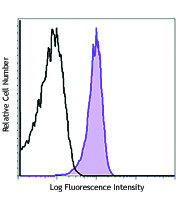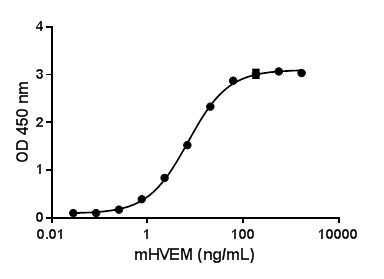- Regulatory Status
- RUO
- Other Names
- Herpes virus entry mediator (HVEM), TNFRSF14, ATAR, TR2, CD270
- Ave. Rating
- Submit a Review
- Product Citations
- publications
| Cat # | Size | Price | Quantity Check Availability | Save | ||
|---|---|---|---|---|---|---|
| 596504 | 20 µg | 76€ | ||||
| 596506 | 100 µg | 175€ | ||||
This product is not available for shipping outside of the United States.
Herpes virus entry mediator (HVEM), a member of the tumor necrosis factor (TNF) receptor family, mediates herpes virus entry into cells during infection. Upon overexpression, HVEM activates NF-kappaB and AP-1 through a TNF receptor-associated factor (TRAF)-mediated mechanism. HVEM ligands belong to two distinct families: the TNF-related cytokines LIGHT and lymphotoxin-α, and the Ig-related membrane proteins BTLA and CD160. HVEM and its ligands have been involved in the pathogenesis of various autoimmune and inflammatory diseases, tumor progression and resistance to immune response. It has been demonstrated that HVEM induces a novel signaling pathway downstream leading to signal transduction and activation of STAT3 in epithelial cells. Since STAT3 regulates the expression of genes important for host defense in epithelial cells, as well as the differentiation of retinoid-related orphan receptor RORγt+, Th17, and innate lymphoid cells. This finding suggests that HVEM may play an important role in mucosal host defense.
Product DetailsProduct Details
- Source
- Human HVEM, amino acids (Leu39-Lys184) (Accession# NP_003811.2) with a human IgG1-Fc tag, was expressed in insect cells.
- Molecular Mass
- The 376 amino acid recombinant protein consists of an N-terminal domain corresponding to the extracellular domain of HVEM and C-terminal portion corresponding to amino acid 102 to 330 of human IgG1. The protein has a predicted molecular mass of approximately 45 kD. The predicted N-terminal amino acid is Leu.
- Purity
- >98%, as determined by Coomassie stained SDS-PAGE.
- Formulation
- Lyophilized
- Endotoxin Level
- Less than 0.1 ng per µg of protein.
- Storage & Handling
- Unopened vial can be stored at -20°C or -70°C. For maximum results, quick spin vial prior to opening. Reconstitute in water to a concentration of 0.1-1.0 mg/ml. Do not vortex. It is recommended to further dilute in a buffer containing a carrier protein such as 0.1% BSA and store in working aliquots at -20°C to -80°C. Avoid repeated freeze/thaw cycles.
- Activity
- Human HVEM-Fc is able to neutralize 0.25 ng/ml of human TNF-β induced cytotoxicity on murine L929 cells. The ED50 is 1.3 - 1.9 µg/ml, corresponding to a specific activity of 5.26 x 102 - 7.69 x 102 units/mg.
- Application
-
Bioassay
- Application Notes
-
This product is reactive with human and mouse.
Antigen Details
- Structure
- Cytokine
- Distribution
-
Spleen, thymus, lung, macrophages, B cells and T cells.
- Function
- HVEM plays a role in mucosal host defense, autoimmune and inflammatory diseases, and tumor progression.
- Ligand/Receptor
- LIGHT, lymphotoxin-alpha.
- Bioactivity
- Neutralize TNFβ induced cytotoxicity on murine L929 cells.
- Cell Type
- Tregs
- Biology Area
- Cell Adhesion, Cell Biology, Immunology, Signal Transduction
- Molecular Family
- Adhesion Molecules, CD Molecules, Immune Checkpoint Receptors
- Antigen References
-
1. Pasero C. et al. 2012. Curr. Opin. Pharmacol. 12:478.
2. Hsu H. et al. 1997. J. Biol. Chem. 272:13471.
3. Mauri DN. et al. 1998. Immunity. 8:21.
4. Montgomery R.I. et al. 1996 Cell. 87:427.
5. Shui J.W. et al. 2012. Nature. 488:222. - Gene ID
- 8764 View all products for this Gene ID
- UniProt
- View information about HVEM on UniProt.org
Related FAQs
- Why choose BioLegend recombinant proteins?
-
• Each lot of product is quality-tested for bioactivity as indicated on the data sheet.
• Greater than 95% Purity or higher, tested on every lot of product.
• 100% Satisfaction Guarantee for quality performance, stability, and consistency.
• Ready-to-use liquid format saves time and reduces challenges associated with reconstitution.
• Bulk and customization available. Contact us.
• Learn more about our Recombinant Proteins. - How does the activity of your recombinant proteins compare to competitors?
-
We quality control each and every lot of recombinant protein. Not only do we check its bioactivity, but we also compare it against other commercially available recombinant proteins. We make sure each recombinant protein’s activity is at least as good as or better than the competition’s. In order to provide you with the best possible product, we ensure that our testing process is rigorous and thorough. If you’re curious and eager to make the switch to BioLegend recombinants, contact your sales representative today!
- What is the specific activity or ED50 of my recombinant protein?
-
The specific activity range of the protein is indicated on the product datasheets. Because the exact activity values on a per unit basis can largely fluctuate depending on a number of factors, including the nature of the assay, cell density, age of cells/passage number, culture media used, and end user technique, the specific activity is best defined as a range and we guarantee the specific activity of all our lots will be within the range indicated on the datasheet. Please note this only applies to recombinants labeled for use in bioassays. ELISA standard recombinant proteins are not recommended for bioassay usage as they are not tested for these applications.
- Have your recombinants been tested for stability?
-
Our testing shows that the recombinant proteins are able to withstand room temperature for a week without losing activity. In addition the recombinant proteins were also found to withstand four cycles of freeze and thaw without losing activity.
- Does specific activity of a recombinant protein vary between lots?
-
Specific activity will vary for each lot and for the type of experiment that is done to validate it, but all passed lots will have activity within the established ED50 range for the product and we guarantee that our products will have lot-to-lot consistency. Please conduct an experiment-specific validation to find the optimal ED50 for your system.
- How do you convert activity as an ED50 in ng/ml to a specific activity in Units/mg?
-
Use formula Specific activity (Units/mg) = 10^6/ ED50 (ng/mL)

 Login / Register
Login / Register 














Follow Us